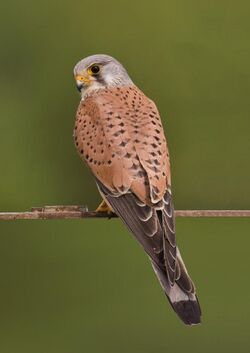Biology:Australaves
| Australaves | |
|---|---|

| |
| Kestrel, Falco tinnunculus | |
| Scientific classification | |
| Domain: | Eukaryota |
| Kingdom: | Animalia |
| Phylum: | Chordata |
| Class: | Aves |
| Clade: | Telluraves |
| Clade: | Australaves Ericson, 2012 |
| Clades | |
Australaves[3] is a recently defined[4] clade of birds, consisting of the Eufalconimorphae (passerines, parrots and falcons) as well as the Cariamiformes (including seriemas and the extinct "terror birds").[5] They appear to be the sister group of Afroaves.[5] As in the case of Afroaves, the most basal clades have predatory extant members, suggesting this was the ancestral lifestyle;[6] however, some researchers like Darren Naish are skeptical of this assessment, since some extinct representatives such as the herbivorous Strigogyps led other lifestyles.[7] Basal parrots and falcons are at any rate vaguely crow-like and probably omnivorous.[8]
| Australaves |
| ||||||||||||||||||
Cladogram of Telluraves relationships based on Kuhl et al. (2020) and Braun & Kimball (2021)[2][9]
References
- ↑ Boles, Walter E. (1997). "Fossil songbirds (Passeriformes) from the Early Eocene of Australia". Emu 97 (1): 43–50. doi:10.1071/MU97004. Bibcode: 1997EmuAO..97...43B.
- ↑ 2.0 2.1 Kuhl, H.; Frankl-Vilches, C.; Bakker, A.; Mayr, G.; Nikolaus, G.; Boerno, S.T.; Klages, S.; Timmermann, B. et al. (2021). "An unbiased molecular approach using 3′-UTRs resolves the avian family-level tree of life". Molecular Biology and Evolution 38 (1): 108–127. doi:10.1093/molbev/msaa191. PMID 32781465.
- ↑ "Identifying localized biases in large datasets: A case study using the Avian Tree of Life.". Molecular Phylogenetics and Evolution (Mol Phylogenet Evol) 69 (3): 1021–1032. 2013. doi:10.1016/j.ympev.2013.05.029. PMID 23791948.
- ↑ Ericson, P. G. (2012). "Evolution of terrestrial birds in three continents: biogeography and parallel radiations". Journal of Biogeography 39 (5): 813–824. doi:10.1111/j.1365-2699.2011.02650.x. Bibcode: 2012JBiog..39..813E.
- ↑ 5.0 5.1 Prum, R.O. et al. (2015) A comprehensive phylogeny of birds (Aves) using targeted next-generation DNA sequencing. Nature 526, 569–573.
- ↑ Jarvis, E. D.; Mirarab, S.; Aberer, A. J.; Li, B.; Houde, P.; Li, C.; Ho, S. Y. W.; Faircloth, B. C. et al. (2014). "Whole-genome analyses resolve early branches in the tree of life of modern birds". Science 346 (6215): 1320–1331. doi:10.1126/science.1253451. PMID 25504713. PMC 4405904. Bibcode: 2014Sci...346.1320J. https://pgl.soe.ucsc.edu/jarvis14.pdf. Retrieved 2015-08-29.
- ↑ Mayr, G. & Ritchter, G. (2011) Exceptionally preserved plant parenchyma in the digestive tract indicates a herbivorous diet in the Middle Eocene bird Strigogyps sapea (Ameghinornithidae). Paläontologische Zeitschrift, Volume 85, Issue 3, pp 303–307.
- ↑ L. D. Martin. 2010. Paleogene avifauna of the holarctic. Vertebrata PalAsiatica 48:367-374
- ↑ Braun, E.L. & Kimball, R.T. (2021) Data types and the phylogeny of Neoaves. Birds, 2(1), 1–22; https://doi.org/10.3390/birds2010001
Wikidata ☰ Q14635103 entry
 |


